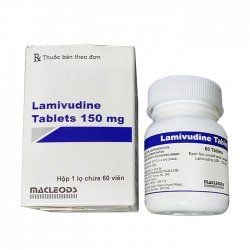This is an automatically translated article.
Nafasera drug with the main ingredient is Adefovir dipivoxil, indicated in the treatment of hepatitis B in adults. Carefully read the instructions for use of Nafasera before using it will help you limit the unwanted effects of the drug.
1. Indications of Nafasera
The main ingredient of Nafasera is Adefovir dipivoxil 10mg. Nafasera is indicated for the treatment of chronic hepatitis B in adults with active viral replication and persistent elevations in serum aminotransferases or histologically progressive disease.2. Contraindications of nafasera
Nafasera is contraindicated in patients with a history of hypersensitivity to Adefovir, Adefovir dipivoxil or any of the excipients.
3. How to take Nafasera
Adults (18 - 65 years old): Take 10mg/day, can be taken with or without food. The exact optimal duration of treatment has not been determined. Children and adolescents (<18 years) and the elderly (>65 years): The safety and effectiveness of Adefovir dipivoxil have not been established. Patients with renal impairment: reduce dose in patients with renal impairment, the interval between doses depends on the patient's creatinine clearance: Creatinine clearance 50ml/min: 10mg dose, once daily. Creatinine clearance 30ml - 49ml/min: 10mg every 48 hours. Creatinine clearance 10ml - 29ml/min: dose 10mg every 72 hours. People on hemodialysis: 10mg every 7 days after dialysis.
4. Undesirable effects of Nafasera
The most common side effects of Nafasera are gastrointestinal disorders including: Vomiting, flatulence, diarrhea, dyspepsia, abdominal pain, headache, weakness, itching and rash. When taking the drug may occur increased plasma creatinine concentration, proximal tubular disease, renal failure, Fanconi's syndrome and hypophosphataemia. Elevated liver enzymes and severe acute hepatitis have been reported after discontinuation of the drug. Lactic acidosis (usually associated with severe hepatomegaly and steatosis) as monotherapy with nucleoside analogues or in combination with antiretrovirals.5. Be careful when using Nafasera
Do not take Nafasera at a higher dose than recommended.
Use Nafasera with caution in the following patients:
Renal failure. Liver failure. HIV co-infection. Children, adolescents under 18 years old and elderly people over 65 years old. People with a history of creatinine deficiency (congenital). Pregnancy: Nafasera should be used during pregnancy only when the potential benefit outweighs the risk to the fetus. Lactation: It is not known whether Nafasera is excreted in human milk. Mothers should be advised not to breast-feed while taking Nafasera.
6. Drug interactions
Concomitant use of Nafasera with drugs that are excreted by the renal tubules or may increase serum concentrations of either adefovir dipivoxil or the combination drug.
Based on the results of in vitro studies and the known excretion pathway of Adefovir, the potential for a CYP450-mediated interaction involving Adefovir and other medicinal products is low.
Co-administration of Nafasera with 100 mg Lamivudine did not change the pharmacokinetics of both drugs.
7. Recognizing the symptoms of an overdose of Nafasera
Symptoms of Nafasera Overdosage: Mild to moderate gastrointestinal effects in HIV-positive patients when taking the drug at a high daily dose 25 - 50 times higher (250mg - 500mg) than the recommended dose report for 14 days.
Treatment of overdose: When symptoms of overdose appear, it is advisable to monitor for signs of toxicity and use supportive measures if necessary.
The article provides information about uses, dosage and notes when using Nafasera. To use Nafasera effectively, patients need to consult and use the drug exactly as directed by the doctor.













